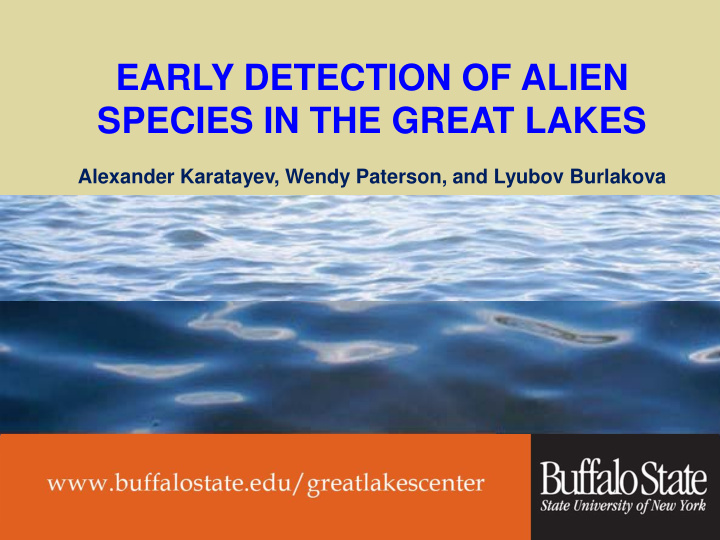



EARLY DETECTION OF ALIEN SPECIES IN THE GREAT LAKES Alexander Karatayev, Wendy Paterson, and Lyubov Burlakova
Sampling Locations For our study we selected four Great Lakes ports from the 11 ports total identified as having the highest risk of invasion ( US EPA Report 2008* ), including: Buffalo and Oswego (sampled in 2014) Toledo and Ashtabula (2015, sampling in progress) Superior Huron *US EPA. 2008. Predicting future introductions of nonindigenous Ontario species to the Oswego Great Lakes. Michigan National Center for Buffalo Environmental Assessment, Erie Washington, DC; Ashtabula EPA/600/R- Toledo 08/066F.
Methods (2014) Samples were taken at 4 sites in the Buffalo and 3 in the Oswego Harbor following HELCOM 2013 Protocol* • Benthos: 15 ponar grabs 6 benthic sleds • Fouling community: 3 settlement plates (exposed for 3 months) 18 wall scrapings • Mobile epifauna: 4 minnow traps for at least 24 hours, 4 light traps at night • Zooplankton: 28 zooplankton tows in May and September (will be processed by Cornell University) • Environmental parameters: Secchi depth, sediment type, temperature, conductivity, and DO *HELCOM, 2013. Report of the HELCOM Aliens 3 Project Port Sampling Workshop. Helsinki Commission
Methods • All organisms were picked live, fixed with 10% neutral buffered formalin, and identified to the lowest possible taxonomic level (usually species, genus or family) • Presence or absence of species was used to analyze different sampling methods
Preliminary Results (30% of samples processed) We found a total of 54 species and higher taxa of invertebrates, including 6 alien species: – Echinogammarus ishnus – Cyclocalyx henslowanum – Schmidtea polychroa – Cordylophora caspia – Dreissena polymorpha – Dreissena rostriformis bugensis We also found an alien fish species (Neogobius melanostomus ) Colonial cnidarian Cordylophora caspia, was found in Oswego Harbor No new alien species were found so far
Preliminary Results • Total taxa found (excluding zooplankton): – 54 (38 in Oswego and 43 in Buffalo) • Total exotic taxa detected: – 7 (7 in Oswego and 6 in Buffalo)
Results • According to the species accumulation curves, the 23 samples taken in Oswego Harbor may have been enough to obtain a realistic estimate of the diversity • The SA curve for Buffalo, however, is not near an asymptote; more samples were needed to access the number of taxa present.
Taxa detected by each sampling method* (a - total number; b - averaged by sample number) *Insects were excluded from the The most efficient sampling methods graphs as they are less likely to be potential invaders ( Karatayev were ponar grab and benthic sled et al. 2009 ).
Exotic taxa (excluding insects) detected by each sampling method • The highest number of exotic species was found in benthic sled • Wall scrapings collected the second largest number of exotic species • When averaged by sample number, the settlement plates collected more exotics per unit effort
Results • The most efficient sampling method was a ponar grab (31 taxa found) • The highest number of exotic species (6 taxa) was found in benthic sled • Wall scrapings collected the second largest number of exotic species. • When averaged by sample number, the settlement plates collected more exotics per unit effort • Live traps were not useful for freshwater benthos
• After the taxonomic identification will be finished and confirmed, the data will be submitted into HELCOM’s database.
Acknowledgments • This project was funded by the Great Lakes Long-term Biological Monitoring Program, US EPA. • We thank Josh Fisher, Brianne Tulumello, Susan Daniel, Knut Mehler, Katie Hastings, Mark Clapsadl, Keith Pawlowski, Jacob Bajdas, Paul Williot, and Matt Bauer (Great Lakes Center), Diann Jackson, Andrew McElwain, Kamal Mohamed, Rachel Corin, Carrie Preston, and Brian Springal (SUNY Oswego), Curtis Karboski and Matt Paufve (USGS Oswego), and Lyndsie Collis, Joseph Cononoly, and Ellen George (Cornell University) for field and laboratory assistance. • We also thank USFWS, HELCOM, and Patricia Schreiber from Buffalo Crushed Stone for provided sampling equipment, methods and advice, and access to sampling location needed for the project.
Recommend
More recommend